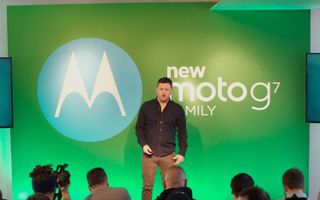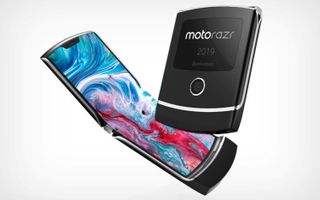Motorola Weighs in on Foldable Razr Rumors, 5GE and New Moto G7
Motorola won't confirm that it's working on a new foldable Razr, but based on an interview with two key executives, a revival of that classic phone certainly seems on the way.
Motorola is launching a trio of solid-looking, value-priced phones in the Moto G7, Moto G7 Play and Moto G7 Power, all of which cost less than $300.
But people can't stop talking about the Wall Street Journal report that the company could revive the Razr in a new foldable-display design, with the device selling for a whopping $1,500.

Kalil also took aim at AT&T's practice of rolling out "5GE" logos on phones as Motorola prepares to launch its own 5G mod for the Moto Z3 on Verizon. "We believe in real 5G,” said Kalil. "We prefer to give consumers the right experience compared to their expectations."
Last but not least, Motorola defended the price increase on the Moto G7. The new phone will cost $299, compared to $249 for last year's Moto G6.
Check out the full interview below.
What are the key differences between the Moto G7 Play, G7 Power and G7?
Thomas Milner: We do a ton of consumer research, and we rely it a lot not only in our marketing but [also] for our device definitions, and we find that there are certain consumers who do want a more compact phone. That's where the new Moto G7 Play comes in.
People can't get enough battery life. That's why we put an industry-leading 5,000-mAh battery in the G7 Power.
The Moto G7 is definitely the more premium-looking design, with Gorilla Glass on both sides. We also have our new U design display, so it really maximizes the screen-to-body ratio. And [we have] the dual cameras.

Is it an issue that the Moto G7 costs $50 more than the G6, that the price is creeping up?
Rudi Kalil: When you look at the portfolio strategy, it's shifted a little bit. We are definitely bringing the [Moto G7] device up. What we're trying to do is find a solution to every price point while trying to address all the consumer pain points.
If you compare what this [$249 Moto G7 Power] device has right now to the original $249 price point for the Moto G6, you're going to see the three-day battery and the big, 6.2-inch screen. So, there's lots of improvements that we are bringing.
Milner: I'm at 97 percent [battery at 11:20 a.m.], and I took the G7 Power off the charger at 6:30 a.m. And I've been looking through my presentation and going through emails.
Apple and Samsung seem to be struggling on the high end. Do you see flagship fatigue setting in?
Milner: Consumers are becoming more and more aware that they are spending all this money on smartphones, and the innovations are very incremental year over year at this point. So, why am I continually spending this money?
So, I think that's a great opportunity for us at this price point. For 90 percent of consumers, [the G7] is going to have everything you need.
Do you feel like consumers are finally warming up to unlocked phones?
Kalil: Consumers are getting better educated, but the migration from consumers buying phones in retail stores versus carrier stores is still not happening as fast in the U.S. as other markets.
How important is it that your G7 line is multiband?
Kalil: Every device that we introduce to the market works across all the carriers. This is something we've been doing since the fourth generation of Moto G, and it's been very successful and why we've been No. 1 in the unlocked space.

If someone puts an AT&T SIM in your phones, will they see the 5GE logo?
Milner: I've been told no.
Can I ask your perspective on that whole 5GE controversy given you're going to have one of the first 5G phones with Verizon?
Kalil: We believe in real 5G. We are the leading manufacturer on real 5G. We prefer to give consumers the right experience compared to their expectations. The 5G Mod [for the Moto Z3] is the right implementation of 5G.
When the Wall Street Journal report came out about the potential revival of the Razr as a foldable phone, the news exploded on the web…
Milner: We have no idea what you're talking about.
Were you guys surprised at the reaction?
Kalil: I think everyone was impressed with the number of articles and the comments, and that is a reflection of everyone being bored with the bars.
People are looking for something that is new.
Milner: There is so much nostalgia for the Razr. It's a phone that redefined what a phone could look like and do with a bigger screen and a sleek form factor, and everybody had one.
That nostalgia — I had no idea it was so alive and well.

Why do you think people are excited about the prospect of the Razr's return? And can you confirm you're making it happen?
Kalil: This industry has become all about specs, and it has lost that fancy, charming side of it. This [report] revives that side of it.
Foldable technology, I'm sure multiple companies are exploring that, but unfortunately we do not talk about future products.
What's your take on the foldable phone trend in general?
Kalil: I think the industry is working on it and multiple display vendors are working on it, but we have not seen any device launched yet. It seems like the technology is not yet mature.
Back in 2016, we had this big event called Tech World in San Francisco where we had a showcase of a foldable device that you would wrap around your wrist. So, foldable technology from a prototype perspective you can find in many places, but it's still rough. But everyone will go there eventually.

What, if any, influence does Lenovo have on your products. Is it more behind the scenes?
Kalil: We were owned by Google, and Google sold us to Lenovo. We continue to be a subsidiary of the parent company. We are the mobile business group for them. We leverage synergies on supply chain and some functional areas, but the development is pretty much all Motorola.
We have development facilities in Brazil, China and Chicago. Some resources came from Lenovo and some from Motorola. We leverage all the resources we have. We are definitely integrated as a company.
How strong is the Motorola brand now?
Kalil: We are No. 4 now here in the U.S. We are No. 2 in Latin America. We have been making a lot of progress. Last year, just to give you a data point, if you look at the U.S. and Canada combined and you look at absolute volumes, we were the No. 1 player in growth, even ahead of Apple. And most of our growth comes from these [G Series] devices.
Milner: It's growing, and that's why we want to introduce more.
Credit: Tom's Guide
Sign up to get the BEST of Tom’s Guide direct to your inbox.
Upgrade your life with a daily dose of the biggest tech news, lifestyle hacks and our curated analysis. Be the first to know about cutting-edge gadgets and the hottest deals.
Mark Spoonauer is the global editor in chief of Tom's Guide and has covered technology for over 20 years. In addition to overseeing the direction of Tom's Guide, Mark specializes in covering all things mobile, having reviewed dozens of smartphones and other gadgets. He has spoken at key industry events and appears regularly on TV to discuss the latest trends, including Cheddar, Fox Business and other outlets. Mark was previously editor in chief of Laptop Mag, and his work has appeared in Wired, Popular Science and Inc. Follow him on Twitter at @mspoonauer.

